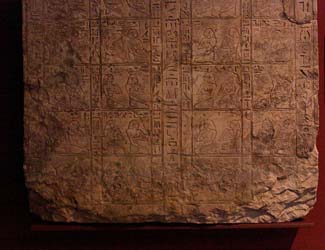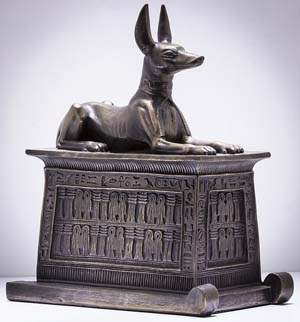A Dysfunctional Family Tree
Several versions exist of how Anubis came into being:
- Son of Nephthys and Osiris: the most popular version is that Anubis is the son of Nephthys and Osiris. As the Goddess of Darkness, Nephthys would naturally be mother to a god who oversaw the embalming process and also guided souls into the afterlife.
- Son of Nephthys and Seth: it is also speculated that Seth is Anubis’ father. In this version, it is believed that Nephthys disguised herself as Osiris’ beautiful sister, Isis, to beget a half brother for Horus. As Seth is the God of darkness, storms and destruction, it is easy to see how Anubis could be his son.
- Son of Nephtys and Ra: in early mythology texts, Ra (the sun God), was depicted as being Anubis’ father, while his mother was speculated as being either Hesat the cow goddess, Bastet the cat-headed warfare goddess, or Nephthys.
Anubis’ wife is called Anput and has the body of a woman and the head of a jackal. Together they have a daughter called Kebechet, who is the goddess of purification.
 © NeferTiyi – Stèle de Nes-kai-chouti
© NeferTiyi – Stèle de Nes-kai-chouti
A Shrine for Anubis
Anubis was worshiped all over Egypt, and his cult center was in Cynopolis, located in the 17th nome (province) of Upper Egypt. Translated, Cynopolis is Greek for “city of the dog,” which fits well because of the close relation between jackals and dogs, and the fact that some scholars believe Anubis was indeed an ancient wolf.
A shrine for Anubis was discovered in King Tut’s tomb in 1922. Made of wood, plaster, lacquer and gold leaf, the statue depicts Anubis in animal form in a recumbent position exactly how he is in his hieroglyph. As the sledge it rested on would indicate, the shrine was probably used in the funeral procession of the great Pharaoh, and was oriented to the west to help guide the Pharaoh into the afterlife (which the ancient Egyptians believed was in the direction of the setting sun).
 © Tony Cash – Anubis
© Tony Cash – Anubis
Anubis in Art
Aside from the Anubis statue discovered in King Tut’s tomb, his representation can be found frequently in ancient Egyptian art. In the Valley of the Kings, an image of Anubis in his role as “Jackal Ruler of the Bows” was often used to seal tombs. The nine bows represented all the enemies of Egypt, and it was believed that Anubis had defeated every one of them. Anubis masks and statuettes dating back to early to late Ptolemaic period (332-30 BC) exist in museums today.
Sneak Peek Anubis Facts
- Anubis was the god of the dead and the underworld until the Middle Kingdom, when this role was taken over by Osiris.
- He is one of the oldest gods, references in text go back as far as the Old Kingdom.
- Anubis is the inventor and god of embalming and mummification.
- He guided the death through the underworld (called Duat).
- Anubis was the Guardian of the Scales, used to weigh the hearts of dead souls.
- His high level of anatomical knowledge due to embalming made him the patron of anesthesiology.
- A crouching statue of Anubis took a central place in Tutankhamun’s tomb.
- Priests who performed the embalming of dead corpses wore a jackal mask.
- Greek mythology blends Hermes with Anubis to result in the god Hermanubis.







































